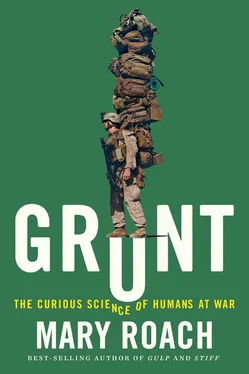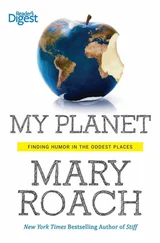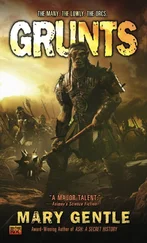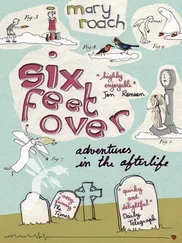EF13 IS lovely this time of year. A late October sun softens the chill and highlights the white butterflies that flit around the bioengineers as they work. The clearing is edged by oaks, changing their outfits before dropping them to the floor. The cadavers too, wear fall colors, one in an orange Lycra bodysuit [11] I emailed Vandue Corp, one of the companies that sell full-body Lycra suits, to see if they were aware of having tapped the cadaver apparel market. The customer care person replied that they were not. Though word had reached them that their product had caught on with bank robbers, as the face is covered but allows the wearer (if living) to see out. Presumably the felon, unlike the Halloween revelers and sports fans who more routinely don Lycra suits, wore some clothing over his. Though I hope not. And I further hope he selected the Sock Monkey pattern.
and one in yellow. For now, they sit slumped in their seats, chins on their chests, like dozing subway commuters. [12] Sleeping subway riders, conversely, look exactly like dead men—a fact born out by the regular appearance of news items about commuters who quietly die and then sit, slumped and unnoticed, through several round-trip circuits of the route. As a passenger quoted in “Corpse Rode the No. 1 Train for Hours” attests, “He just looked like he was asleep.”
Because the setup takes two days, the dead men spent the night in the meadow. A portable weather shelter was erected to protect the electronics, and a pair of guards took turns watching from a truck parked nearby. Bear Point may not have bears anymore, but it does have coyotes, and neither death nor Lycra dampens a coyote’s enthusiasm for meat.
Under the platform is a small plot of simulated Middle East: engineered soil that has been heated and moistened as per protocol. Consistency and repeatability being key elements of the work. At around 2:30 p.m., a pickup truck will arrive with a few pounds of the explosive C-4, which everyone here has been referring to as “the threat.” Around 2:45, the bioengineers and investigators and hangers-on like me will be escorted to a nearby bunker while the threat is buried in the special dirt and a detonating wire is attached. Then the wood staircase to the tower platform will be pulled away (so the carpenters don’t have to keep rebuilding it), and an alarm will sound three times. After which the threat becomes the event. The Tower, the Threat, the Event. It’s like a tarot deck out here.
It’s just past noon now. The cadavers are having their connectivity rechecked after the long drive in. Data will be gathered from sensors mounted on their bones and then transmitted along wires laid down along the insides of their limbs and spines—a sort of man-made nervous system. As with the real deal, the nerves lead to a brain, in this case the WIAMan Data Acquisition System. A bundle of wires exit at the back of each specimen’s neck and feed into the system.
After the blast, the cadavers will be autopsied and the injuries documented. This is the information that will allow vehicle evaluators to interpret the g-forces and strains and accelerations that WIAMan’s sensors will register. Because of the cadavers’ contributions, WIAMan will be able to predict what kind and what degree of injury these different magnitudes of force would be likely to cause in an actual explosion. WIAMan won’t be done until 2021, but in the meantime, the cadaver injury data can be used to create a transfer function, a sort of auto-translate program for the Hybrid III.
By now the cadavers have been coaxed into a straight-backed dinner-table posture, some duct tape keeping them from slumping. (In coming months, data will be gathered for more realistic positions—legs stretched out in front or angled back under the seat.) A bioengineer holds one of the heads in his hands, like a man in a movie preparing to kiss his co-star. Another strings thin wires to hold the head in that eyes-right position, though not so firmly that it interferes with its movements, which will be captured on video cameras set up in bunkers on all four sides. There’s a protocol for everything: the angle of the cadavers’ knees, the position of their hands on their thighs, the newtons of force with which their boots are laced.
The bucolic calm of the setting belies the pressure everyone’s under to get the bodies prepped on schedule. A butterfly lands, unnoticed, on a bioengineer’s shoulder. Jays converse, or seem to, with the scratchy calls of duct tape being pulled from the roll. The hover and fuss of the scientists exaggerates the abiding stillness of the bodies. They’re like anchormen sitting for their makeup. How nice for them to be outdoors on this fine, crisp autumn day, I find myself thinking. How nice to be in the company of people who appreciate what they’ve agreed to do, this strange job that only they, as dead people, are qualified to do. To feel no pain, to accept broken bones without care or consequence, is a kind of superpower. The form-fitting Lycra costumes, it occurs to me, are utterly appropriate.
Not everyone feels the way I do. In 2007, someone at the Pentagon complained to the Secretary of the Army about a preliminary WIAMan test. “I’ll never forget,” says Randy Coates, WIAMan’s project director until his retirement in 2015. “It was a Wednesday evening, about seven o’clock. I got a call from a colonel over at Aberdeen, where we were going to run the test. He says, ‘The Secretary of the Army has shut down the test.’ We had three cadavers and a team of people who’d been working on them around the clock for days.” As Brockhoff recalls it, “Someone felt their personal beliefs had been affronted.” Her boss went to the Secretary and tried to explain: You can’t build a human surrogate without understanding how the human responds. And then he got mad. To shut down the project at the last moment like that would be not only an extravagant waste of money but a waste of the donors’ bodies. Sometime on Friday, the last possible day before decomposition would have invalidated the results, the test was cleared to go forward—surely the first cadaveric research venture with multiple two- and three-star generals in attendance.
Jason Tice, who oversees WIAMan live-fire testing, pointed out that the sudden, intense scrutiny may have had a silver lining. “It’s been informing leadership about the risks they’re subjecting soldiers to.” In other words, my words, maybe they’ll worry a little less about the dead and a little more about the living.
The downside to the Pentagonal hullabaloo is a newly bloated approval process. The protocol for research involving cadavers has to be approved by the head of the Army Research Laboratory and by ARL’s overseeing organization, the Research, Development and Engineering Command. From there it goes to the commanding general of the Army Medical Research and Materiel Command, which in turn passes it on to the Surgeon General of the Army, who sends it to Congress. Who have two weeks to respond. And if no one along the way takes issue, then and only then can the work begin. The whole process can take as much as six months.
The other fallout is a newly drafted “sensitive use” policy. Potential body donors are required to have given specific consent for research or testing that may involve, as the document lays it out, “impacts, blasts, ballistics testing, crash testing and other destructive forces.”
Who would sign such a thing? Plenty of people. Sometimes, Coates says, it’s people who like the idea of doing something to help keep military personnel safe. It’s a way of serving your country without actually enlisting. I can imagine there are people who, while drawn to the nobility of risking life and limb for a greater cause, would prefer to do so while already dead. Mostly, I’m guessing, it’s the same sorts of people who donate their remains for any other worthy endeavor that relies on the contributions of the insensate. If you’re fine with a medical student dissecting every inch of you to learn anatomy, or with a surgeon practicing a new procedure or trying out a new device on you, then you are probably fine riding the blast rig. I won’t be needing it, is the typical donor attitude toward his or her remains. Do what you have to do to make good from it.
Читать дальше












